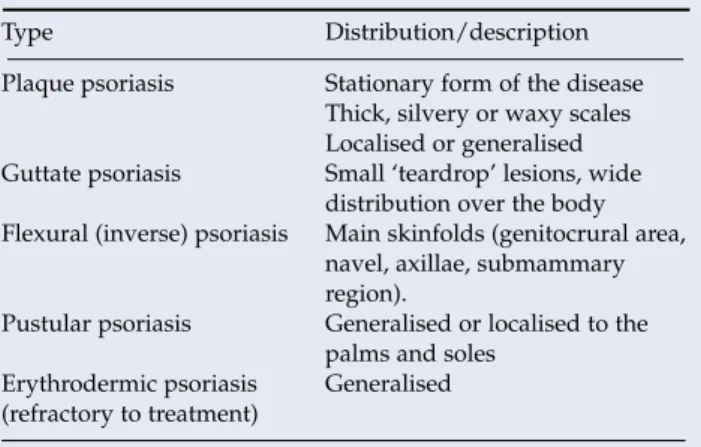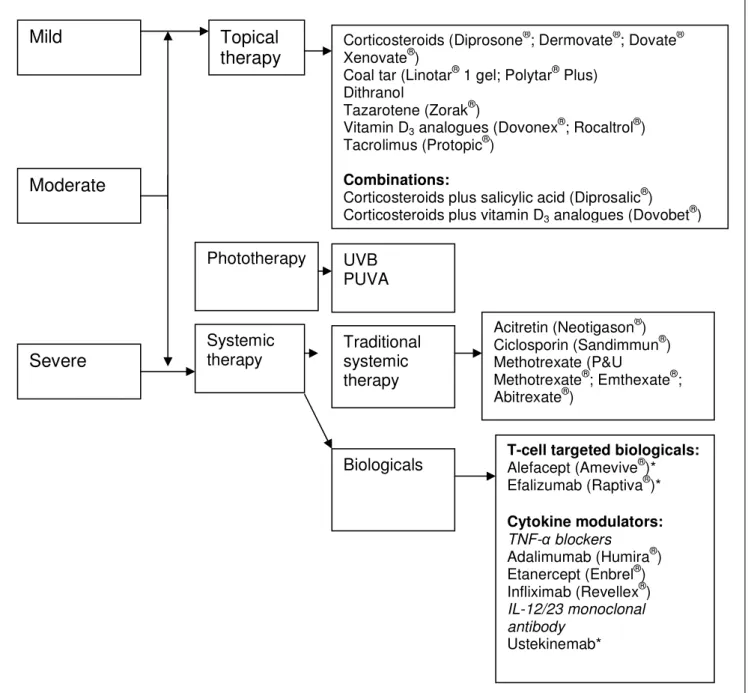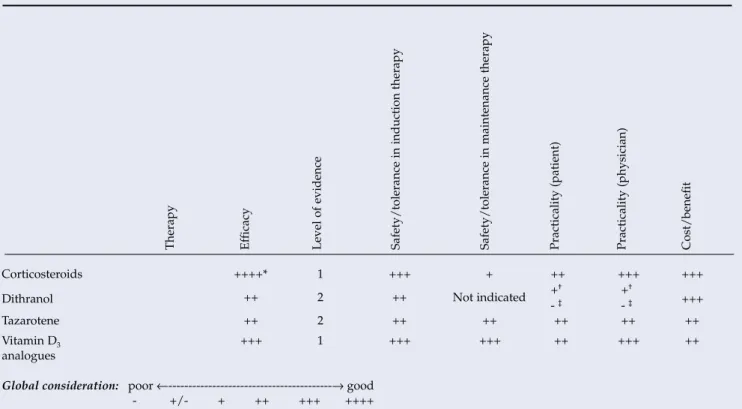It is caused by an overgrowth of diphtheroids, which are part of the normal skin flora. Hyperkeratotic palmar eczema and palmoplantar pustulosis can be difficult to distinguish from psoriasis. Ideally, practical demonstrations of treatment application should be provided by appropriately trained members of a primary health care team.
This section of the guidelines has been adapted with written permission from the authors of the German guidelines for psoriasis.32,33. The selection of the class of corticosteroids must be tailored to the specific skin area to be treated. The evaluation of the effectiveness column reflects the percentage of patients who achieved a reduction in the baseline Psoriasis Area and Severity Index (PASI) of approximately
Important contraindications Acute, erythrodermic forms of psoriasis; Pustular Psoriasis Important Adverse Reactions Burning and redness of the skin in >10%. Based on extensive study data and superior efficacy, this recommendation is particularly true for calcipotriol. Especially in the case of patients with a high cumulative UV dose, regular skin cancer screenings should be performed for the rest of the patient's life.
For notes on the definitions of the various parameters, refer to the bottom of Table X.

Excimer laser
Systemic therapy
Acitretin (oral retinoids) (Table XX) Background
In combination with topical corticosteroids (2 series; N=160) and topical calcipotriol (2 studies; N=221), the combination was more effective than acitretin monotherapy. They concluded that the evidence for the effectiveness of acitretin as combination or monotherapy was weak due to heterogeneous study results and did not recommend its routine use. Retinoids may be less effective than other systemic agents as monotherapy for the short-term management of moderate to severe chronic psoriasis, but they are used effectively in combination with phototherapy and topical agents or for long-term maintenance of agent-induced clearing. others.35,38.
A systematic review of chronic palmoplantar pustulosis interventions found established but modest evidence supporting the use of oral retinoid monotherapy to induce and maintain remission. Effectiveness for psoriatic arthritis, compared to placebo, has been demonstrated in a small study summarized in a systematic review.41. The use of acitretin is associated with a large number of side effects and toxicity reactions (Table XX).
Compared with other systemic interventions for severe psoriasis, the potential for serious harm appears to be less.35,38,39. More effective than placebo, but less effective than cyclosporine (at a dose of 75 mg/d)36 Combination therapy37. Because of its long half-life, contraception should be used for at least 2 years after stopping use.
Elevated triglycerides can be seen in up to 25% of patients and should be monitored. Other Contraception should be used in patients of childbearing age for at least 2 years after discontinuation of acitretin. You should not donate blood during and for at least 2 years after stopping the use of acitretin.
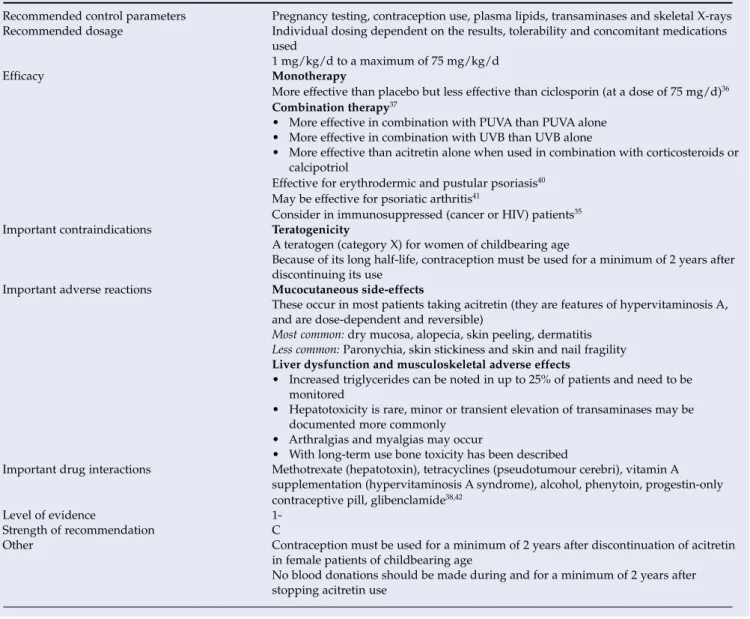
Ciclosporin (Table XXI) Background
Both cyclosporine (3–4 mg/kg/day) and methotrexate (0.5 mg/kg/week) were shown to be effective in a study from India (N=30), but methotrexate appeared to result in faster and more complete clearance . Side effects were transient and minor.44 In contrast, in a study in the Netherlands (N=88), there were no differences in efficacy, tolerability, remission rate, time to remission, or quality of life outcome. There was no difference in quality of life and side effects were common but acceptable.
Although both agents were effective, cyclosporine was more effective in the short-term treatment of moderate to severe chronic plaque psoriasis.46. They concluded that there is good evidence and an acceptable risk/benefit ratio for cyclosporine as effective monotherapy for remission induction of moderate to severe plaque psoriasis, but advised caution with long-term use due to the renal side effects. A systematic review and meta-analysis of RCTs evaluating the efficacy (PASI-75) and tolerability (overall rate of withdrawal) of systemic treatments for moderate to severe psoriasis from Europe and North America found 9 trials for cyclosporine that met inclusion criteria.47 The response (PASI-75) ranged from 25% to 97%, and the variability was only partly explained by variable dosing.
Open-label studies had more patients reach PASI-75 than double-blind placebo-controlled trials. Due to heterogeneity associated with an overestimation of efficacy in open-label studies, only double-blind placebo-controlled trials (3/9) of ciclosporin were included in the meta-analysis of 16 studies for biologics. In a systematic review of psoriatic arthropathy interventions, no RCTs were available to evaluate the use of ciclosporin.41 Side effects.
Cyclosporine is metabolized in the liver, so bioavailability and plasma levels are altered by drugs that affect the cytochrome P450 3A enzyme system. Cyclosporine use is associated with a large number of side effects and toxicity reactions due to the narrow therapeutic index, low threshold for toxicity and plasma levels that are easily affected by inducers, inhibitors and substrates of cytochrome P450 3A. The incidence and severity of side effects seen in patients with psoriasis correlate with the cumulative dose and/or duration of use.37.
Methotrexate (Table XXII) Background
Both methotrexate (0.5 mg/kg/wk) and cyclosporine (3 - 4 mg/kg/d) were found to be effective in a study from India (N=30), but methotrexate appeared to produce a more rapid and complete clearance. In an international randomized, double-blind, double-dummy, placebo-controlled study (Canadian and European cohort N=271), a patient response rate of PASI-75 was achieved in 79.6% of patients who received adalimumab (80 mg subcutaneous week 0 ) then 40 mg every 2 weeks), 35.5% of those given methotrexate (7.5 - 25 mg/week orally) and 18.9% of those receiving placebo for 16 weeks. All patients received 5 mg of folate weekly, 48 hours after oral medication (CHAMPION study).49 Methotrexate dose, treatment duration and the use of folate may explain the different responses noted above.
Placebo comparisons include the CHAMPION study49 and an RCT of methotrexate use for psoriatic arthritis.41 In 37 patients who received methotrexate (7.5 - 15 mg/week orally) or placebo for 12 weeks, a reduction in psoriasis -area noted for methotrexate compared to placebo. They concluded that methotrexate as monotherapy was effective for moderate to severe plaque psoriasis despite the lack of definitive studies, but its use was limited by the controls needed during therapy and contraindications. Although widely accepted as effective, methotrexate has been shown to be effective for psoriatic arthritis in only one high-dose parenteral study in a systematic review of psoriatic arthropathy interventions.
The use of methotrexate is associated with a large number of side effects and toxic reactions.43 Excretion takes place via the kidneys, so the level of the drug is affected by kidney function (Table XXII). Liver biopsy is indicated in patients at risk of liver fibrosis (diabetes, overweight, history of liver problems, total dose > 1.5 g) when methotrexate is used for a long time as maintenance therapy. Management of acute toxicity Leucovorin (folinic acid) rescue: 20 mg of folinic acid should be given parenterally within 48 hours of the last dose.
A systematic review of its use in rheumatoid arthritis (RA) failed to show any benefit due to a lack of uniformity of outcome measures, but did support the protective effects of folate for gastrointestinal (GI) and mucosal side effect reduction . The dose of folic acid or folic acid did not seem to matter.50 A recent randomized placebo-controlled study in RA patients (N=454) showed that folate supplementation is protective against hepatotoxicity.
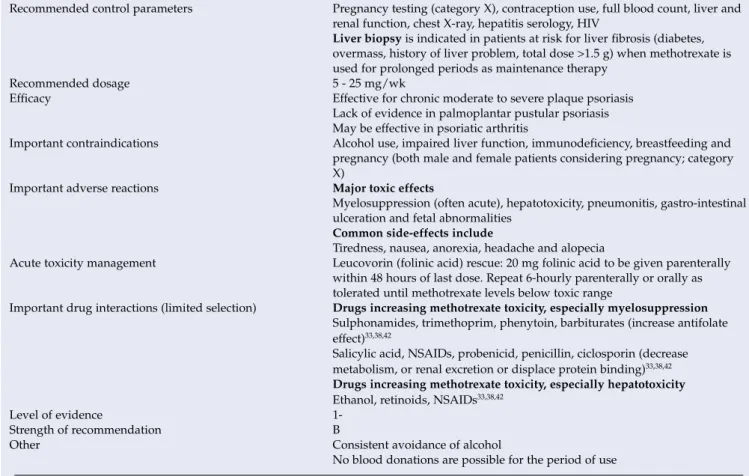
Alternative systemic therapies
Hydroxyurea/hydroxycarbamide (Table XXIII) Background
A review of the use of hydroxyurea in psoriasis55 found a previous report of a small RCT comparing hydroxyurea (1 g/day) with methotrexate (2.5 mg/day) in 8 patients in a 2 × 6-week crossover study. Two open case series summarized in the British Association of Dermatology guidelines54 and the above review55 report that >60% of 60 and 85 patients treated with hydroxyurea, respectively, achieved a good or excellent response (38/60 achieved 60–80% clearance, 10/60 no response; 51/85 clear or almost clear, 6/80 no response). Responses were observed within the first 6 weeks of treatment and the response was maintained during treatment.
Additional case series were identified in the review.55 In 100 patients treated with hydroxyurea (1 g/day treated for variable periods over 8 years) a 'valuable' response was seen in 63/100 patients including 18 'excellent' responses '. An open-label study of 31 patients with chronic plaque psoriasis in India reported a good but slow response to hydroxyurea dosed at 1.0 g - 1.5 g/day. Macrocytosis was seen in all patients after 2 weeks and all side effects were reported to be mild and reversible.57.
A systematic review of chronic palmoplantar pustulosis interventions found 1 small (13 patients), short, crossover trial comparing hydroxyurea with placebo. A systematic review of chronic psoriatic arthritis interventions found no evaluable evidence for the efficacy of hydroxyurea.41.
Sulfasalazine (Table XXIV) Background
Biologicals
Overview and background information
Biological agents are proteins that can be extracted from animal tissue or produced by recombinant DNA technology and possess pharmacological activity.58 Biological therapies block specific molecular steps in the pathogenesis of psoriasis. The nomenclature of biological drugs is standardized and the drug name suffix aids in identification (Table XXV).
Strategies for biological therapy in psoriasis
Considerations for biological therapy
Rheumatology Society eligibility criteria for treatment with anti-TNF agents in relation to skin disease. This is defined as a 50% or more reduction in baseline PASI score (or percent BSA where PASI is not applicable) and a 5-point or more improvement in DLQI within 3 months of starting treatment. Therapy should be withdrawn if the criteria for adequate response are not met within 3 months.
Treatment should be initiated and monitored (Table XXVI) by consultant dermatologists experienced in the management of intractable psoriasis.
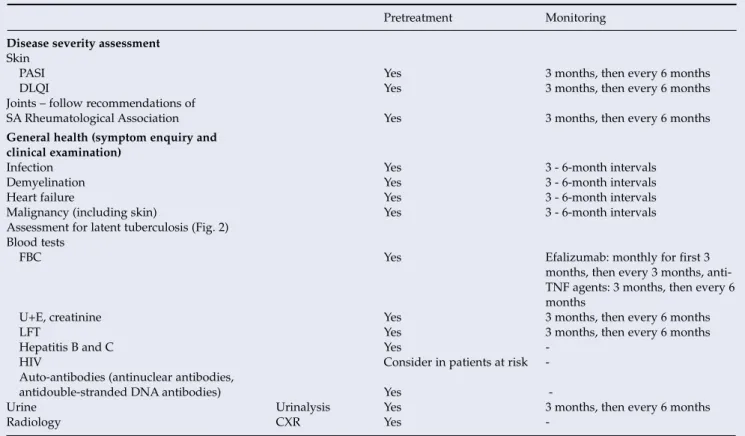
G uideline
1Group 1
THORACIC PHYSICIAN
- T-cell-targeted biologicals .1 Alefacept
- Cytokine modulators: TNF-α blockers .1 Adalimumab
- Other cytokine modulators
- Comparative short-term efficacy of the biologicals Two recent meta-analyses have been performed to summarise
- Areas for future research
- Choice of agents
Smith CH, Anstey AV, Barker JNWN, et al and Ormerod AD (Chair of the Guidelines Group).


